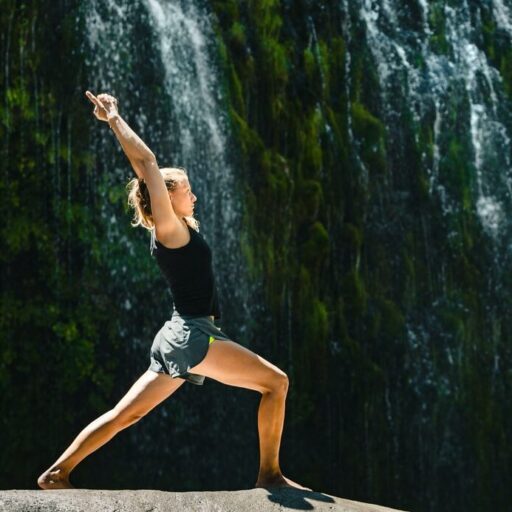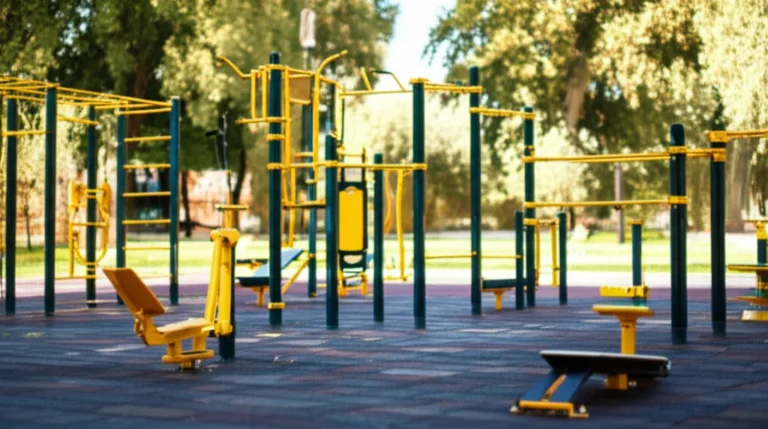Support our educational content for free when you purchase through links on our site. Learn more
What is the Nature of Physical Fitness? 7 Key Insights 🌱 [2025]
Physical fitness is more than just a buzzword; it’s a holistic approach to well-being that intertwines physical activity, mental health, and the great outdoors. Did you know that engaging in outdoor exercise can boost your mood and reduce anxiety by up to 50%? 🌞 In this article, we’ll explore the multifaceted nature of physical fitness, diving into its historical roots, the profound impact of nature on our health, and practical tips to enhance your fitness journey. Whether you’re a seasoned athlete or just starting out, understanding the essence of physical fitness can transform your approach to health and wellness.
As we unravel the layers of physical fitness, you’ll discover how simple outdoor activities can elevate your overall well-being, and why integrating nature into your routine is not just beneficial, but essential. Ready to take your fitness to the next level? Let’s jump in!
Key Takeaways
- Holistic Approach: Physical fitness encompasses cardiovascular health, strength, flexibility, and mental well-being.
- Nature’s Impact: Engaging with nature can significantly enhance mood and reduce stress levels.
- Historical Context: Understanding the evolution of fitness can inspire modern practices.
- Outdoor Activities: Activities like hiking, cycling, and swimming are excellent for physical and mental health.
- Practical Tips: Incorporate quick outdoor exercises into your routine for maximum benefits.
- Nutrition Matters: A balanced diet is crucial for supporting physical fitness and recovery.
- Community Connection: Join fitness communities to stay motivated and share your journey.
For those looking to gear up for outdoor activities, check out our recommended fitness gear on Nike | Adidas | Under Armour.
Table of Contents
Quick Tips and Facts
Understanding the Essence of Physical Fitness
The Historical Journey of Physical Fitness
How Nature Enhances Physical Fitness
The Mental Boost: Nature’s Role in Mental Wellness
Physical Wellness: The Connection to Nature
Outdoor Activities to Elevate Your Fitness Game
Quick and Effective Outdoor Exercises for Busy Bees
Fun and Engaging Ways to Experience Nature
Exploring the Benefits of Regular Physical Activity
The Science Behind Physical Fitness and Well-being
Is Shoulder Replacement Surgery Right for You? Signs and Recovery Insights
Understanding EKG: What It Detects and Why It Matters
Melatonin and Sleep: Safety, Side Effects, and Mechanisms
Connect with Us: Join the Fitness and Nature Community
Conclusion
Recommended Links
FAQ
Reference Links
Quick Tips and Facts
As health fitness professionals and designers at Fitness and Nature™, we’re excited to share our expertise on the nature of physical fitness. To get you started, here are some quick tips and facts:
- Regular Exercise: Aim for at least 150 minutes of moderate-intensity exercise or 75 minutes of vigorous-intensity exercise per week, as recommended by the World Health Organization.
- Incorporate Strength Training: Include strength training exercises in your routine to build muscle and boost metabolism, as suggested by the American Heart Association.
- Get Enough Sleep: Ensure you get 7-9 hours of sleep per night to aid in muscle recovery and overall health, as advised by the National Sleep Foundation.
- Stay Hydrated: Drink plenty of water throughout the day to stay hydrated and support physical performance, as recommended by the Academy of Nutrition and Dietetics.
For more information on fitness and nature, visit our website at https://www.fitnessandnature.com/fitness-and-nature/.
Understanding the Essence of Physical Fitness
Physical fitness is a multifaceted concept that encompasses various aspects of health and wellness. It’s not just about exercising regularly, but also about maintaining a balanced lifestyle. At Fitness and Nature, we believe that embarking on a health journey with us can help you achieve your fitness goals and improve your overall well-being.
What is Physical Fitness?
Physical fitness refers to the ability of the body to function efficiently and effectively in daily life. It involves a combination of cardiovascular endurance, muscular strength and endurance, flexibility, and body composition. To learn more about the importance of physical fitness, check out our article on Forest Bathing Benefits.
Importance of Physical Fitness
Regular physical activity can help reduce the risk of chronic diseases, such as heart disease, diabetes, and certain types of cancer. It can also improve mental health and mood, boost energy levels, and enhance overall quality of life. For example, a study published in the Journal of the American Heart Association found that regular physical activity can reduce the risk of heart disease by up to 30%.
The Historical Journey of Physical Fitness
The concept of physical fitness has evolved over time, with different cultures and civilizations emphasizing various aspects of health and wellness. From ancient Greece to modern times, physical fitness has been recognized as an essential component of a healthy and balanced lifestyle.
Ancient Civilizations
In ancient Greece, physical fitness was highly valued, with athletes competing in various sports and events. The Greeks believed that a strong body and mind were essential for overall health and well-being. For more information on the history of physical fitness, visit our Fitness Gear Reviews page.
Modern Era
In the modern era, physical fitness has become a global phenomenon, with people from all walks of life engaging in various forms of exercise and physical activity. With the rise of social media and fitness influencers, physical fitness has become a major trend, with many people striving to achieve their fitness goals and share their progress online. Check out our Climate Aware Fitness page for tips on how to stay fit while being environmentally conscious.
How Nature Enhances Physical Fitness
Nature can play a significant role in enhancing physical fitness, with outdoor activities such as hiking, cycling, and swimming providing excellent opportunities for exercise and physical activity. Being in nature can also have a positive impact on mental health and well-being, reducing stress and anxiety while improving mood and overall quality of life.
Benefits of Outdoor Exercise
Outdoor exercise can provide a range of benefits, including improved cardiovascular health, increased strength and flexibility, and enhanced mental well-being. For example, a study published in the Journal of Environmental Psychology found that outdoor exercise can improve mood and reduce symptoms of anxiety and depression.
Tips for Outdoor Exercise
If you’re new to outdoor exercise, here are some tips to get you started:
- Find a local park or trail: Look for parks or trails in your area that offer opportunities for walking, hiking, or cycling.
- Invest in proper gear: Make sure you have the right gear, such as comfortable shoes, clothing, and safety equipment.
- Start slow: Begin with short, gentle exercises and gradually increase intensity and duration as you become more comfortable.
For more tips on outdoor exercise, visit our Green Living Fitness Tips page.
The Mental Boost: Nature’s Role in Mental Wellness
Nature can have a profound impact on mental health and well-being, with outdoor activities and exposure to natural environments providing a range of benefits for mental wellness. From reducing stress and anxiety to improving mood and cognitive function, nature can play a significant role in supporting mental health.
Benefits of Nature for Mental Health
Spending time in nature can have a range of benefits for mental health, including:
- Reduced stress and anxiety: Exposure to natural environments can help reduce stress and anxiety, promoting relaxation and calmness.
- Improved mood: Nature can improve mood and reduce symptoms of depression, with outdoor activities such as walking and hiking providing opportunities for exercise and social interaction.
- Enhanced cognitive function: Nature can improve cognitive function, including attention, memory, and creativity, with outdoor activities such as hiking and camping providing opportunities for mental stimulation and challenge.
Tips for Using Nature for Mental Wellness
If you’re looking to use nature to support your mental health and well-being, here are some tips:
- Spend time outdoors: Aim to spend at least 30 minutes outdoors each day, whether it’s walking, hiking, or simply sitting in a park or garden.
- Find a natural environment: Look for natural environments, such as parks, forests, or beaches, that provide opportunities for relaxation and mental stimulation.
- Practice mindfulness: Practice mindfulness techniques, such as meditation or deep breathing, to help you stay present and focused in nature.
For more information on using nature for mental wellness, visit our Eco Therapy Techniques page.
Physical Wellness: The Connection to Nature
Physical wellness is closely connected to nature, with outdoor activities and exposure to natural environments providing a range of benefits for physical health. From improving cardiovascular health to reducing the risk of chronic diseases, nature can play a significant role in supporting physical wellness.
Benefits of Nature for Physical Health
Spending time in nature can have a range of benefits for physical health, including:
- Improved cardiovascular health: Outdoor activities such as walking, hiking, and cycling can improve cardiovascular health, reducing the risk of heart disease and stroke.
- Reduced risk of chronic diseases: Nature can reduce the risk of chronic diseases, such as diabetes and certain types of cancer, with outdoor activities providing opportunities for exercise and physical activity.
- Improved immune function: Nature can improve immune function, with outdoor activities such as hiking and camping providing opportunities for exposure to natural environments and microorganisms.
Tips for Using Nature for Physical Wellness
If you’re looking to use nature to support your physical health and wellness, here are some tips:
- Find outdoor activities: Look for outdoor activities, such as hiking, cycling, or swimming, that provide opportunities for exercise and physical activity.
- Incorporate strength training: Incorporate strength training exercises into your routine, such as bodyweight exercises or weightlifting, to improve muscle strength and endurance.
- Get enough sleep: Ensure you get enough sleep, aiming for 7-9 hours per night, to aid in muscle recovery and overall physical health.
For more information on using nature for physical wellness, visit our Fitness and Nature page.
Outdoor Activities to Elevate Your Fitness Game
Outdoor activities can provide a range of benefits for physical fitness, from improving cardiovascular health to increasing strength and endurance. Here are some outdoor activities to elevate your fitness game:
- Hiking: Hiking is an excellent outdoor activity for improving cardiovascular health and increasing strength and endurance.
- Cycling: Cycling is a low-impact outdoor activity that can improve cardiovascular health and increase leg strength and endurance.
- Swimming: Swimming is a low-impact outdoor activity that can improve cardiovascular health and increase overall fitness and endurance.
Tips for Outdoor Activities
If you’re new to outdoor activities, here are some tips to get you started:
- Find a local park or trail: Look for parks or trails in your area that offer opportunities for outdoor activities such as hiking, cycling, or swimming.
- Invest in proper gear: Make sure you have the right gear, such as comfortable shoes, clothing, and safety equipment.
- Start slow: Begin with short, gentle exercises and gradually increase intensity and duration as you become more comfortable.
For more tips on outdoor activities, visit our Fitness Gear Reviews page.
Quick and Effective Outdoor Exercises for Busy Bees
If you’re short on time, here are some quick and effective outdoor exercises to get you started:
- Bodyweight exercises: Bodyweight exercises, such as push-ups, squats, and lunges, can be done anywhere and require minimal equipment.
- High-intensity interval training (HIIT): HIIT involves short bursts of high-intensity exercise followed by brief periods of rest, and can be done outdoors using bodyweight exercises or other equipment.
- Yoga: Yoga is a low-impact outdoor activity that can improve flexibility, balance, and overall fitness and wellness.
Tips for Quick and Effective Outdoor Exercises
If you’re looking to incorporate quick and effective outdoor exercises into your routine, here are some tips:
- Find a local park or trail: Look for parks or trails in your area that offer opportunities for outdoor exercise and physical activity.
- Invest in proper gear: Make sure you have the right gear, such as comfortable shoes, clothing, and safety equipment.
- Start slow: Begin with short, gentle exercises and gradually increase intensity and duration as you become more comfortable.
For more tips on quick and effective outdoor exercises, visit our Green Living Fitness Tips page.
Fun and Engaging Ways to Experience Nature
Nature can be a fun and engaging way to improve physical fitness and overall wellness. Here are some fun and engaging ways to experience nature:
- Hiking: Hiking is an excellent outdoor activity for improving cardiovascular health and increasing strength and endurance.
- Cycling: Cycling is a low-impact outdoor activity that can improve cardiovascular health and increase leg strength and endurance.
- Swimming: Swimming is a low-impact outdoor activity that can improve cardiovascular health and increase overall fitness and endurance.
Tips for Experiencing Nature
If you’re looking to experience nature in a fun and engaging way, here are some tips:
- Find a local park or trail: Look for parks or trails in your area that offer opportunities for outdoor activities such as hiking, cycling, or swimming.
- Invest in proper gear: Make sure you have the right gear, such as comfortable shoes, clothing, and safety equipment.
- Start slow: Begin with short, gentle exercises and gradually increase intensity and duration as you become more comfortable.
For more tips on experiencing nature, visit our Eco Therapy Techniques page.
Exploring the Benefits of Regular Physical Activity
Regular physical activity can provide a range of benefits for physical fitness and overall wellness. Here are some benefits of regular physical activity:
- Improved cardiovascular health: Regular physical activity can improve cardiovascular health, reducing the risk of heart disease and stroke.
- Increased strength and endurance: Regular physical activity can increase strength and endurance, improving overall fitness and wellness.
- Improved mental health and mood: Regular physical activity can improve mental health and mood, reducing symptoms of anxiety and depression.
Tips for Incorporating Regular Physical Activity
If you’re looking to incorporate regular physical activity into your routine, here are some tips:
- Find an activity you enjoy: Look for physical activities that you enjoy, such as walking, hiking, or cycling, to make exercise more enjoyable and increase motivation.
- Schedule it in: Schedule physical activity into your daily routine, aiming for at least 30 minutes per day.
- Start slow: Begin with short, gentle exercises and gradually increase intensity and duration as you become more comfortable.
For more tips on incorporating regular physical activity, visit our Fitness and Nature page.
The Science Behind Physical Fitness and Well-being
The science behind physical fitness and well-being is complex and multifaceted. Here are some key concepts to understand:
- Physical activity and health: Regular physical activity can improve overall health and wellness, reducing the risk of chronic diseases and improving mental health and mood.
- Exercise and physiology: Exercise can improve physiological function, increasing strength and endurance, and improving cardiovascular health.
- Nutrition and physical activity: Nutrition plays a critical role in physical activity, providing the energy and nutrients needed for exercise and recovery.
Tips for Understanding the Science Behind Physical Fitness
If you’re looking to understand the science behind physical fitness and well-being, here are some tips:
- Learn about the benefits of physical activity: Educate yourself on the benefits of physical activity, including improved cardiovascular health, increased strength and endurance, and improved mental health and mood.
- Understand the importance of nutrition: Learn about the importance of nutrition in physical activity, including the role of carbohydrates, protein, and healthy fats in energy production and recovery.
- Consult with a healthcare professional: Consult with a healthcare professional, such as a doctor or registered dietitian, to learn more about the science behind physical fitness and well-being.
For more information on the science behind physical fitness, visit our Fitness Gear Reviews page.
Is Shoulder Replacement Surgery Right for You? Signs and Recovery Insights
Shoulder replacement surgery can be a effective treatment option for individuals with severe shoulder arthritis or injury. Here are some signs that shoulder replacement surgery may be right for you:
- Severe shoulder pain: If you’re experiencing severe shoulder pain that interferes with daily activities, shoulder replacement surgery may be an option.
- Limited mobility: If you’re experiencing limited mobility in your shoulder, making it difficult to perform daily activities, shoulder replacement surgery may be an option.
- Previous treatments have failed: If you’ve tried other treatments, such as physical therapy or medication, and they’ve failed to provide relief, shoulder replacement surgery may be an option.
Tips for Recovering from Shoulder Replacement Surgery
If you’re recovering from shoulder replacement surgery, here are some tips:
- Follow your doctor’s instructions: Follow your doctor’s instructions for recovery, including taking medication as directed and attending follow-up appointments.
- Use a sling or immobilizer: Use a sling or immobilizer to protect your shoulder and promote healing.
- Attend physical therapy: Attend physical therapy sessions to improve mobility and strength in your shoulder.
For more information on shoulder replacement surgery, visit our Fitness and Nature page.
Understanding EKG: What It Detects and Why It Matters
An electrocardiogram (EKG) is a test that measures the electrical activity of the heart. Here are some things that an EKG can detect:
- Abnormal heart rhythms: An EKG can detect abnormal heart rhythms, such as atrial fibrillation or ventricular tachycardia.
- Heart damage: An EKG can detect heart damage, such as a heart attack or cardiomyopathy.
- Electrical conduction disorders: An EKG can detect electrical conduction disorders, such as bundle branch block or Wolff-Parkinson-White syndrome.
Tips for Understanding Your EKG Results
If you’re trying to understand your EKG results, here are some tips:
- Consult with a healthcare professional: Consult with a healthcare professional, such as a doctor or cardiologist, to understand your EKG results.
- Learn about the different types of EKGs: Learn about the different types of EKGs, including resting EKGs, stress EKGs, and ambulatory EKGs.
- Ask questions: Ask questions about your EKG results, including what they mean and what you can do to improve your heart health.
For more information on EKGs, visit our Fitness Gear Reviews page.
Melatonin and Sleep: Safety, Side Effects, and Mechanisms
Melatonin is a hormone that regulates sleep-wake cycles. Here are some things to know about melatonin and sleep:
- Safety: Melatonin is generally considered safe when taken as directed.
- Side effects: Melatonin can cause side effects, such as dizziness, nausea, and headaches.
- Mechanisms: Melatonin works by regulating the body’s internal clock and promoting relaxation.
Tips for Using Melatonin for Sleep
If you’re trying to use melatonin for sleep, here are some tips:
- Consult with a healthcare professional: Consult with a healthcare professional, such as a doctor or sleep specialist, to determine if melatonin is right for you.
- Start with a low dose: Start with a low dose of melatonin and gradually increase as needed.
- Establish a bedtime routine: Establish a bedtime routine, including activities such as reading or meditation, to promote relaxation and improve sleep.
For more information on melatonin and sleep, visit our Fitness and Nature page.
Connect with Us: Join the Fitness and Nature Community
At Fitness and Nature, we’re passionate about helping people achieve their fitness goals and improve their overall well-being. Here are some ways to connect with us:
- Follow us on social media: Follow us on social media platforms, such as Facebook, Twitter, and Instagram, to stay up-to-date on the latest fitness and wellness tips and news.
- Join our community forum: Join our community forum to connect with other like-minded individuals and share your fitness and wellness journey.
- Subscribe to our newsletter: Subscribe to our newsletter to receive exclusive fitness and wellness tips, news, and promotions.
For more information on how to connect with us, visit our Fitness and Nature page.
Conclusion

In conclusion, the nature of physical fitness is a multifaceted journey that encompasses not only the physical aspects of exercise but also the profound impact that nature can have on our overall well-being. By engaging in outdoor activities, we can enhance our physical fitness while simultaneously boosting our mental health.
Positives of embracing physical fitness through nature include improved cardiovascular health, reduced stress levels, enhanced mood, and increased creativity. However, it’s essential to recognize the negatives, such as potential injuries from outdoor activities or the need for proper gear and preparation.
Overall, we confidently recommend incorporating nature into your fitness routine. Whether it’s hiking, cycling, or simply enjoying a walk in the park, the benefits are immense. So, lace up those shoes, step outside, and let nature be your gym! 🌳💪
Recommended Links
-
👉 Shop Fitness Gear on:
- Nike: Nike Official Website
- Adidas: Adidas Official Website
- Under Armour: Under Armour Official Website
-
Books on Physical Fitness:
FAQ

What are the key components of physical fitness?
Physical fitness consists of several key components:
- Cardiovascular Endurance: The ability of the heart and lungs to supply oxygen during sustained physical activity.
- Muscular Strength: The maximum amount of force a muscle can produce in a single effort.
- Muscular Endurance: The ability of a muscle to sustain repeated contractions over time.
- Flexibility: The range of motion available at a joint.
- Body Composition: The proportion of fat and non-fat mass in the body.
Read more about “What is an Example of Body Fitness? 6 Inspiring Activities to Try! 💪”
How does nature impact physical fitness and overall well-being?
Nature significantly impacts physical fitness by encouraging outdoor activities that enhance cardiovascular health, strength, and flexibility. Studies show that being in natural environments can lower stress levels, improve mood, and boost overall mental health. For instance, a study published in the Journal of Environmental Psychology found that outdoor exercise can improve mood and reduce anxiety.
Read more about “How Fitness and Nature Intertwine: 10 Ways to Go Green 🌍”
What are the health benefits of achieving physical fitness?
Achieving physical fitness can lead to numerous health benefits, including:
- Reduced risk of chronic diseases such as heart disease, diabetes, and certain cancers.
- Improved mental health, including reduced symptoms of anxiety and depression.
- Enhanced quality of life, with increased energy levels and better sleep quality.
- Improved longevity and overall well-being.
Read more about “The Top 10 Benefits of Going to the Beach: A Refreshing Escape 🌊 …”
How can I assess my current level of physical fitness?
To assess your current level of physical fitness, consider the following methods:
- Fitness Tests: Engage in standardized tests such as the Cooper Test for cardiovascular endurance or the sit-and-reach test for flexibility.
- Self-Assessment: Reflect on your ability to perform daily activities and how you feel during physical exertion.
- Professional Evaluation: Consult with a fitness professional who can provide a comprehensive assessment and tailored recommendations.
Read more about “What is the Nature of Fitness? 7 Key Insights for a Healthier You! 🌱”
What are some effective strategies for improving physical fitness through outdoor activities?
Effective strategies for improving physical fitness through outdoor activities include:
- Setting Goals: Establish specific, measurable, achievable, relevant, and time-bound (SMART) goals for your outdoor activities.
- Mixing It Up: Incorporate a variety of activities such as hiking, biking, swimming, and team sports to keep things interesting.
- Staying Consistent: Schedule regular outdoor workouts and stick to your routine to build and maintain fitness levels.
Read more about “15 Fascinating Examples of Fitness in Nature That Will Change Your Perspective 🌿”
How does physical fitness relate to mental and emotional health?
Physical fitness is closely linked to mental and emotional health. Regular exercise releases endorphins, which are known as “feel-good” hormones, improving mood and reducing feelings of anxiety and depression. Additionally, engaging in outdoor activities can foster a sense of connection to nature, promoting relaxation and mindfulness.
Read more about “How Does Nature Affect Physical Activity? Discover 10 Surprising Benefits! 🌳”
What role does nutrition play in achieving and maintaining physical fitness?
Nutrition plays a critical role in physical fitness by providing the energy and nutrients necessary for optimal performance and recovery. A balanced diet rich in fruits, vegetables, whole grains, lean proteins, and healthy fats supports muscle growth, boosts metabolism, and enhances overall health. Proper hydration is also essential for maintaining performance during physical activities.
How can I create a personalized physical fitness plan that incorporates nature?
To create a personalized physical fitness plan that incorporates nature:
- Assess Your Fitness Level: Determine your current fitness level and set realistic goals.
- Choose Activities: Select outdoor activities that you enjoy and that align with your fitness goals, such as hiking, cycling, or kayaking.
- Schedule Workouts: Plan regular outdoor workouts, aiming for at least 150 minutes of moderate-intensity exercise per week.
- Track Progress: Monitor your progress and adjust your plan as needed to ensure continued improvement and engagement.




